Summarizing a paragraph is one of those underrated skills that quietly shows up everywhere, in academic papers, business emails, meeting notes, and even in everyday conversations.
Now, at first glance, summarizing sounds like a simple “just shorten it” task.
But if you rush it or skip a few steps, you’ll either leave out something important or end up repeating the original in a slightly rearranged form.
A good summary takes strategy. And once you learn how to do it right, it becomes a skill you can rely on again and again.
So, in this article, I’m breaking down exactly how to summarize a paragraph effectively.
Let’s get into it.
Key Takeaways:
- To understand how to summarize a paragraph, you must understand it first and then capture the core idea in fewer, clearer words.
- A good summary is concise, objective, and original with no personal opinions and no copied phrasing.
- To write a good summary, read carefully, identify the topic sentence, highlight essential supporting details, and understand the author’s purpose.
- Summarizing and paraphrasing are not the same. Summarizing condenses text in fewer words, while paraphrasing rewrites with the same level of detail using your own words.
What Does It Mean to Summarize a Paragraph?
Summarizing a paragraph means taking a longer chunk of writing and rewriting its core idea(s) using fewer, clearer words.
A lot of people assume that summarizing is just about shortening the paragraph. Cut a few lines here, drop some words there, and you’re done.
But that’s not the crux of a summary. A real summary shows that you read something, understood it, and can explain it simply.
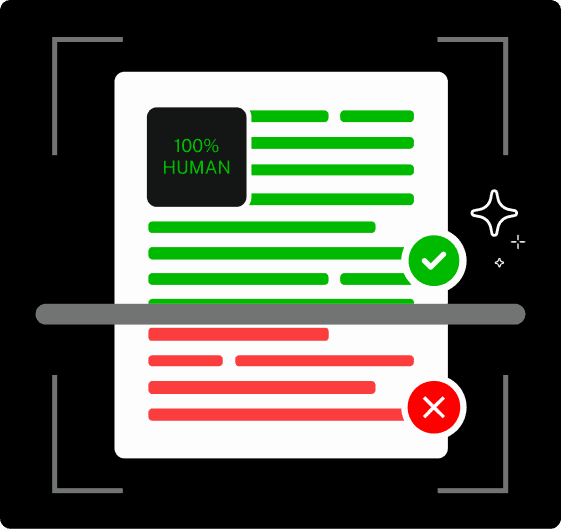
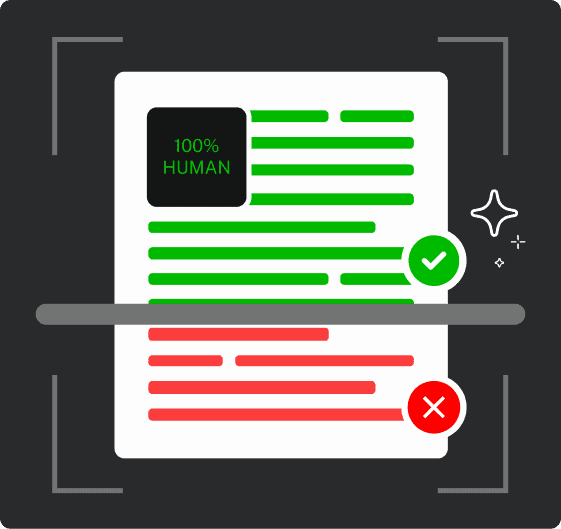
Never Worry About AI Detecting Your Texts Again. Undetectable AI Can Help You:
- Make your AI assisted writing appear human-like.
- Bypass all major AI detection tools with just one click.
- Use AI safely and confidently in school and work.
We summarize things all the time, probably without even realizing it.
When your friend asks, “What did that article say?” and you respond with a quick explanation, you’ve summarized it.
When you come out of a meeting and explain the main takeaway to someone who missed it, that’s summarizing.
Key Principles of Paragraph Summarization
Here are the core principles that actually make a summary useful and worth reading.
- It should be concise: A summary should be short, but that doesn’t mean you just cut the paragraph in half and hit “submit.” You want to say only what’s necessary without omitting any key details.
- You should stay objective: Summarizing does not mean you can insert your own thoughts, reactions, or side comments. If the paragraph says something you strongly disagree with, save the debate for later. Right now, your job is to represent the original idea as clearly and neutrally as possible.
- You should avoid plagiarism: A summary should always be in your own words. If you’re summarizing something written by someone else, make sure you’re genuinely rewriting it and not recycling the sentence structure or phrasing.
And if you’ve used AI tools to help generate a summary (which is totally fine, by the way), take a minute to humanize the output.
You can use the Undetectable AI Humanizer to make it sound more natural and human.
How to Summarize a Paragraph in Your Own Words
Now that we have established what a good summary looks like, let’s discuss the steps needed to write a good summary.
To speed up your workflow, first learn how to summarize a paragraph in your own words, then use Undetectable AI Chat and Humanizer to refine it.
We’ll use this text on digital marketing produced by Undetectable AI Chat to demonstrate how to summarize a paragraph example.
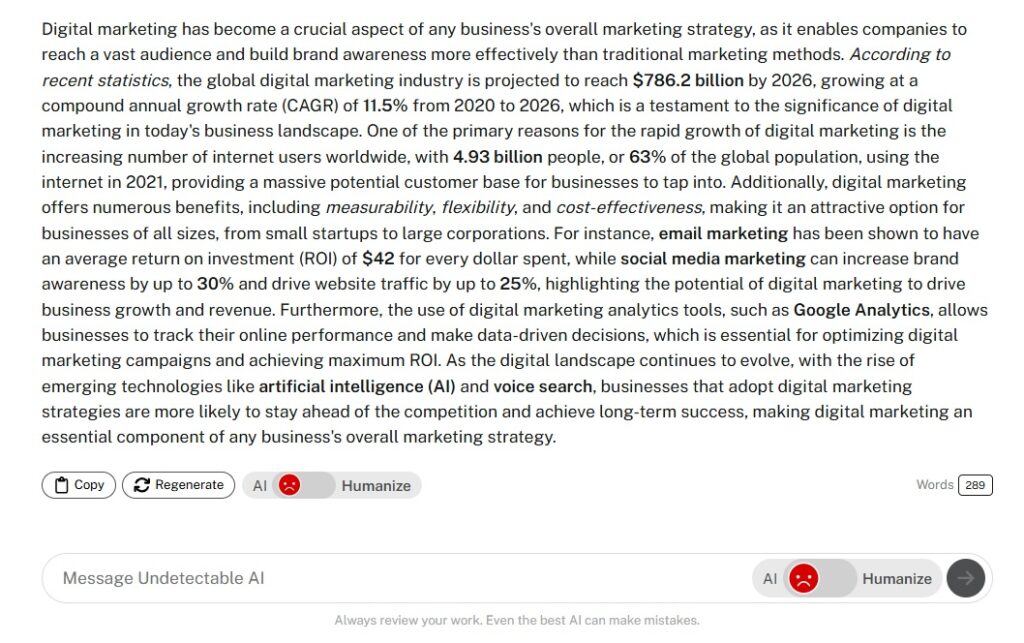
Step 1: Read the Paragraph Carefully
It sounds obvious, but most of us skim when we think we’re reading. Summarizing a paragraph, though, demands more than a casual glance.
You must read the paragraph all the way through to really understand what it means.
Pay attention to any repetition. If the same idea shows up more than once, that’s a big neon sign flashing that it is important.
If the paragraph is packed with dense language or unfamiliar terms, pause to reread it and break it down. Sometimes you have to read it twice, once to get the flow and once to catch the details.
After reading, try to say (out loud or in your head), “This paragraph is mostly about…” If you can’t finish that sentence confidently, you’re not ready to summarize yet.
Step 2: Identify the Topic Sentence
In most cases, the topic sentence is the first one. Sometimes, it hides in the second or even third line if the writer’s warming up before getting to the point.
To find that sentence, ask yourself, “If I had to pick one sentence that sums up what this whole paragraph is trying to say, which one would it be?”
It is the sentence that would still give you the big picture when you remove all the supporting details, quotes, or examples.
Identifying the topic sentence gives you your foundation, and the rest of the summary becomes way easier.
You can simply put the paragraph into Undetectable AI Chat and ask it to identify the topic sentence for you to make your life easier.
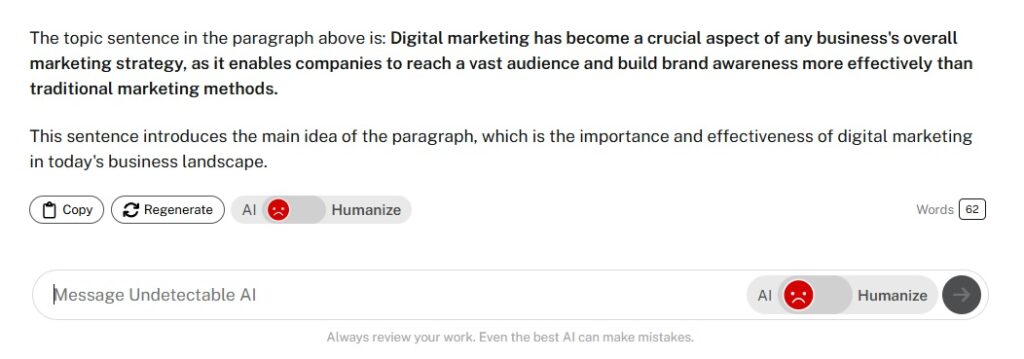
Step 3: Highlight Supporting Details
Once you’ve nailed down the topic sentence, you need to zoom in on the details that hold it up.
These include facts, examples, reasons, or explanations that give depth to the main point.
Without them, the paragraph would be just a vague statement gloating in space.
Look at the sentences that come after the topic sentence and highlight anything that makes the topic sentence clearer or more convincing.
If it’s just repeating something or going off on a tangent, you can probably skip it.
Again, just ask the AI Chat to pull the supporting details for you to save yourself time and energy.
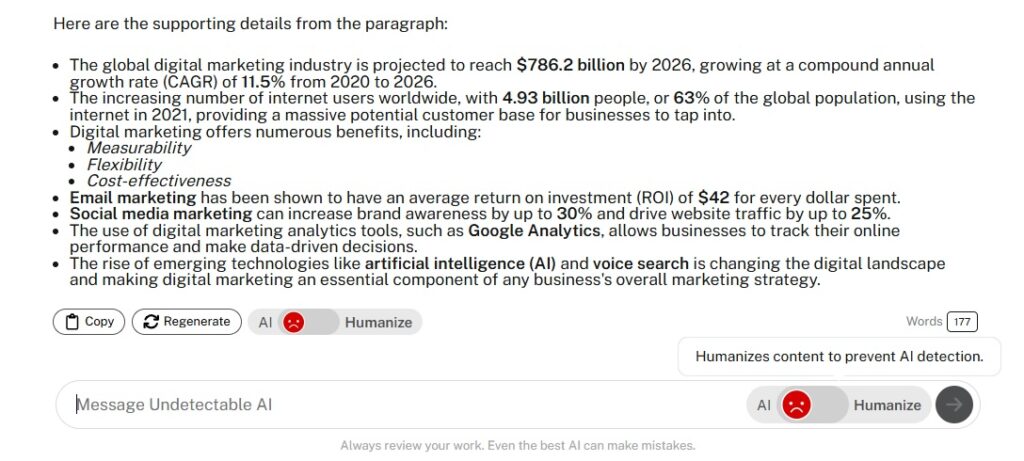
Step 4: Determine the Author’s Purpose
Now that you’ve got the main idea and the supporting details, you need to know why the author even wrote this paragraph in the first place.
Are they trying to explain something? Convince you of an argument? Describe a process? Share a fact?
If the paragraph is packed with facts and stats, the purpose is probably to inform.
If it sounds a little persuasive, like the author’s trying to change your mind, then it’s to convince.
If it’s emotional or full of personal stories, the goal may be to connect or entertain.
Knowing the author’s intent helps you capture not just what they’re saying, but why they’re saying it.
In our example of digital marketing, the goal is most likely to inform the reader about its relevance and importance.
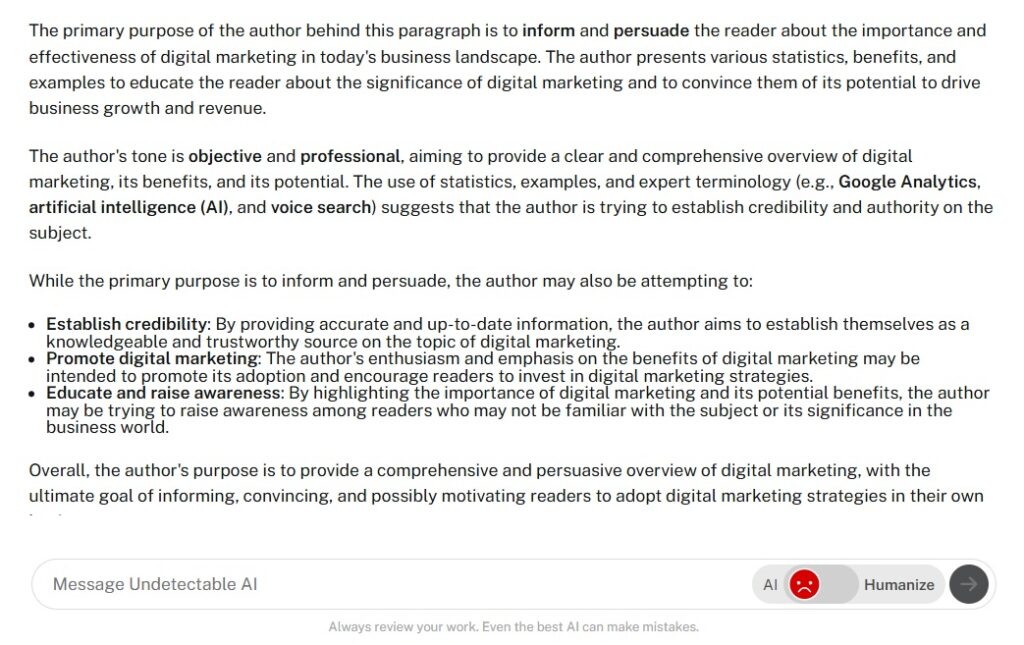
Step 5: Write the Summary Using Your Own Words
This is the moment everything comes together. The first rule in how to summarize a body paragraph is no copying. You can’t just pluck the topic sentence and slap it in quotes.
You must translate the paragraph into your own words after actually processing the information and expressing it the way you would explain it to someone else.
Keep your summary short. Just a few sentences are enough for a single paragraph.
Keep your focus only on the main idea and the most relevant supporting point(s), and cut all the fluff.
Here is the summary of the paragraph we have been using as the example using Undetectable AI Chat:


If you used AI tools to help you generate a rough draft (totally fair game), run it through Undetectable AI Humanizer to clean it up.
Step 6: Revise for Clarity and Brevity
Read your summary out loud and see if someone who hasn’t read the original paragraph still understands what it’s about.
If you’re tripping over your own sentence or running out of breath halfway through, it’s probably too wordy.
Look for extra words that don’t need to be there, i.e., words that repeat the same ideas or vague phrases like “in order to” instead of just “to.”
A summary should sound neutral and to-the-point, not dramatic, sarcastic, or emotional.
If you accidentally slipped in your opinion or threw in something that wasn’t in the original paragraph, now’s the time to trim it.
When to Summarize vs. Paraphrase

Summarizing vs. paraphrasing both involve rewriting someone else’s ideas in your own words.
So it’s easy to confuse the two and assume they’re interchangeable. However, they’re not the same thing. And naturally, their use cases differ too.
Summary vs. Paraphrase: What’s the Difference?
A summary requires taking a larger chunk of text and condensing it down to just the essential point or two.
You don’t have to rewrite every line. All you need to do is identify the heart of the message and state it as simply and briefly as possible.
Paraphrasing, on the other hand, is more of a line-by-line translation.
While paraphrasing, you keep the same length, tone, and level of detail as the original but put it entirely in your own words.
You still need to cover every major point the original author made without copying their exact language.
Here are the 5 best tools to paraphrase without AI detection.
When to Use Each in Academic or Business Writing
Summaries and paraphrases serve different purposes.
For example, if you’re writing a literature review and need to show that several researchers agree on a trend, there’s no need to spell out every study in full. A summary will get the job done.
Summaries also come in handy when you’re focusing more on your own argument than the original source. Just a quick nod to the source’s main point lets you shift back to your analysis.
Similarly, in business writing, when your time is tight and your audience just wants the takeaways, you resort to summarizing.
Executive summaries, client updates, and team briefings are all places where no one has time (or patience) for a word-for-word breakdown.
You want to paraphrase a text when engaging more deeply with a specific idea.
For example, you can pull in the full idea without quoting every word while analyzing a theory or responding to a detailed point in a scholarly article.
Business teams paraphrase text when relaying a customer’s feedback to the product team.
Professionals who know how to summarize a paragraph effectively can easily turn lengthy documents into clear, actionable summaries.
Try out our AI Detector and Humanizer in the widget below!
FAQs About Summarizing a Paragraph
How Long Should a Paragraph Summary Be?
A paragraph summary should be one to three sentences long, depending on the length and complexity of the original paragraph.
Can You Use Direct Quotes in a Summary?
Generally, no. A summary should be in your own words. However, you can use direct quotes only if a specific phrase is essential or uniquely said.
Should You Cite the Source When Summarizing?
Yes, you should always cite the source when summarizing. Although you’re using your own words, the ideas still belong to the original author.
Final Thoughts
Learning how to summarize a paragraph is a skill that pays off in many ways. It sharpens your thinking and helps you communicate clearly.
Try using Undetectable AI Chat to spot key highlights in any chunk of text.
The AI Paraphraser has your back when you want to rework that topic sentence without sounding robotic. Finally, run it through the AI Humanizer for clean, natural-sounding output.
Try Undetectable AI suite of tools, and you’ll be summarizing like an expert in no time.
